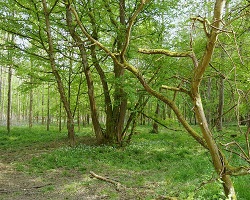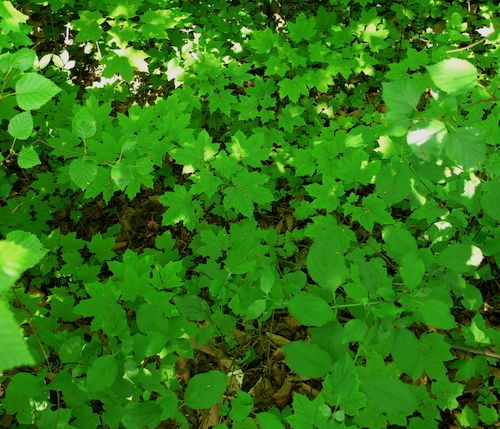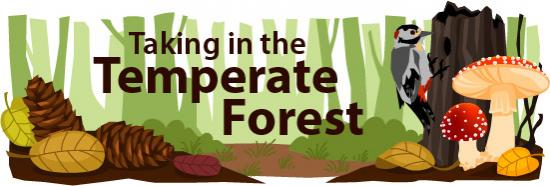show/hide words to know
Climax: the top or final state of something, like an ecosystem.
Pioneer: the first to move into an area. In plants, pioneers are usually very fast growing and can't survive in shade.
Tolerate: to allow or endure something or someone that is unfavorable. In medical terms, it is a person's ability to take a drug or treatment without serious side effects or discomfort.
Anatomy of the Temperate Forest

Trees are a defining feature of the structure of a temperate forest. Image by Adbar.
It’s all about the trees. Trees are the most important members of the temperate forest community. They provide the structure and create the environment for everything beneath them. The forest can be thought of in “layers” with the treetops being the top layer, called the canopy. Small plants grow in the understory, on the bottom right above the forest floor.
Stunted by Shade
There can also be subcanopy or intermediate layers, where young trees grow; these will be giants some day when they reach the canopy. The shade that the canopy makes can make it hard for some plants to survive in the forest, because they can’t get enough light to grow. While a tree may produce thousands of seeds in a given year to blanket the forest floor with seedlings, less than one out of every 100 of these seedlings will survive. It’s a harsh life for a little seedling.
Changing Seasons

As green chlorophyll is broken down, we can see the other leaf pigments (yellow here). Nitrogen is also released from this break down and the plants reabsorb it for future use. Image by Lite.
Fall brings beautiful colors of all different shades to the deciduous forests. Some maples turn orange, oak leaves show dark reds, and hickories become bright yellow. These colors are clues that the trees are shutting down for the winter.
Peeking Underneath
But the trees and understory aren't where all the action happens in a temperate forest. There’s a lot more to soil than just dirt. If you go out to the forest and pick up a pinch of soil, how many species do you think you’d be holding? There’s a good chance there are more than 50,000 species between your fingertips!
Very diverse communities of microbes, including bacteria and fungi, populate temperate forest soils, consuming and decomposing the plant litter and animal remains that fall there.
These microbes go dormant in the winter too, just like the trees. This allows nutrients and dead plant litter to build up in the soil so that it can be rich enough to support lots of plant growth. When spring comes, they start decomposing again.
Images via Wikimedia Commons. Seedlings image by FLamiot.
View Citation
Bibliographic details:
- Article: Anatomy of the Temperate Forest
- Author(s): Drew Peltier
- Publisher: Arizona State University School of Life Sciences Ask A Biologist
- Site name: ASU - Ask A Biologist
- Date published: July 21, 2014
- Date accessed: April 17, 2024
- Link: https://askabiologist.asu.edu/anatomy-temperate-forest
APA Style
Drew Peltier. (2014, July 21). Anatomy of the Temperate Forest. ASU - Ask A Biologist. Retrieved April 17, 2024 from https://askabiologist.asu.edu/anatomy-temperate-forest
Chicago Manual of Style
Drew Peltier. "Anatomy of the Temperate Forest". ASU - Ask A Biologist. 21 July, 2014. https://askabiologist.asu.edu/anatomy-temperate-forest
Drew Peltier. "Anatomy of the Temperate Forest". ASU - Ask A Biologist. 21 Jul 2014. ASU - Ask A Biologist, Web. 17 Apr 2024. https://askabiologist.asu.edu/anatomy-temperate-forest
MLA 2017 Style

In temperate forests, young tree seedlings often blanket the forest floor.
Be Part of
Ask A Biologist
By volunteering, or simply sending us feedback on the site. Scientists, teachers, writers, illustrators, and translators are all important to the program. If you are interested in helping with the website we have a Volunteers page to get the process started.










